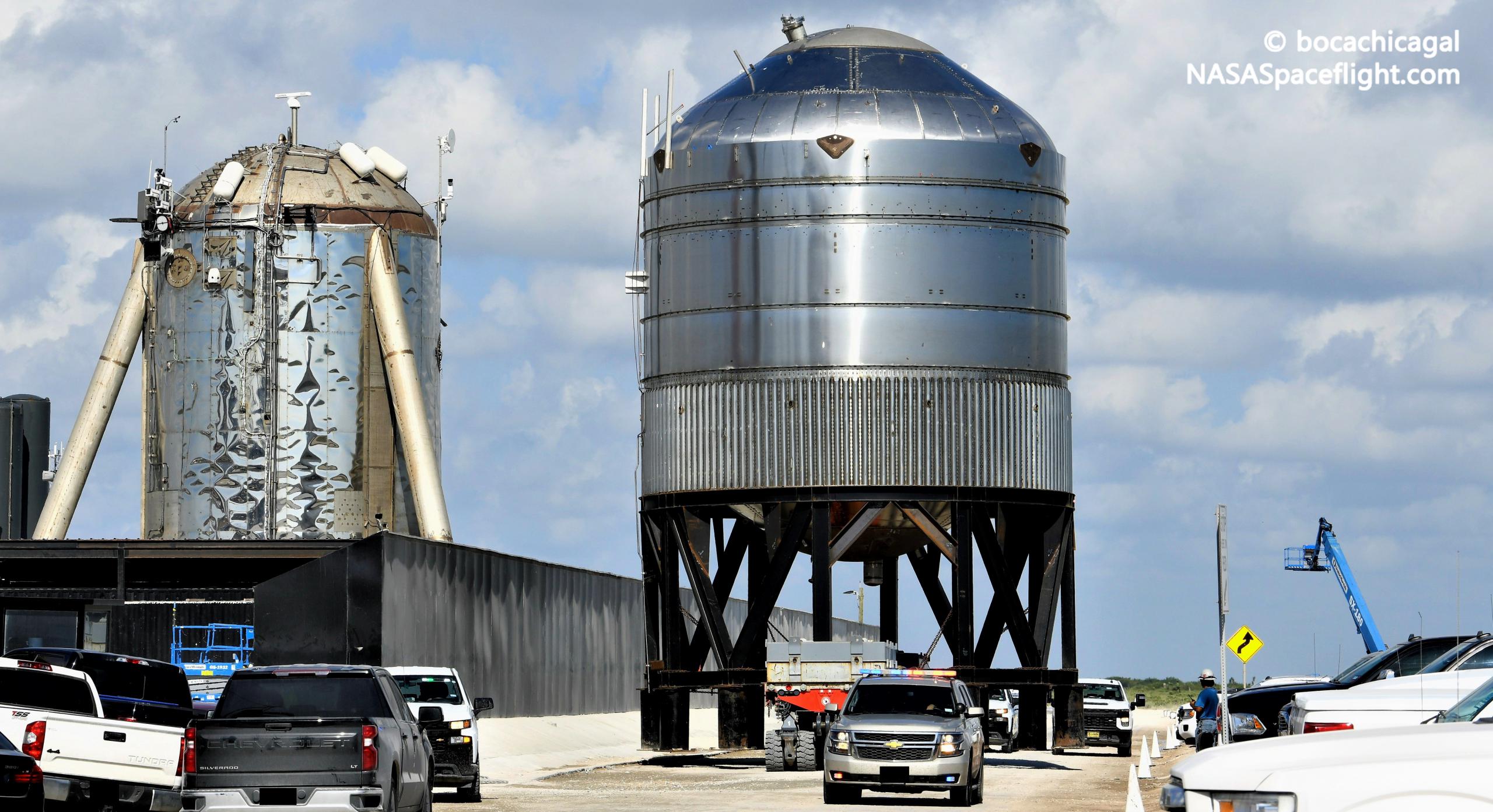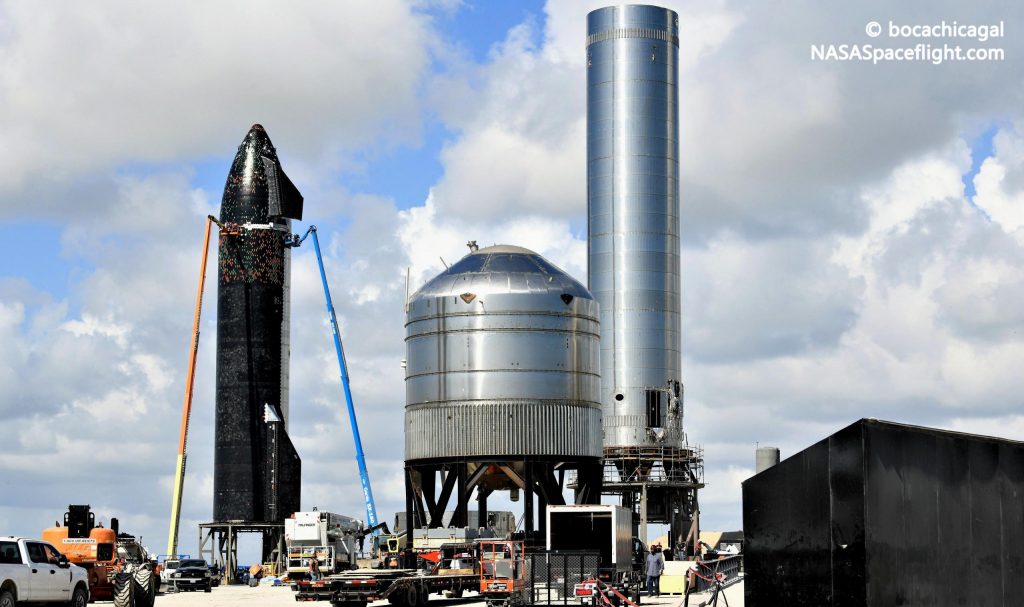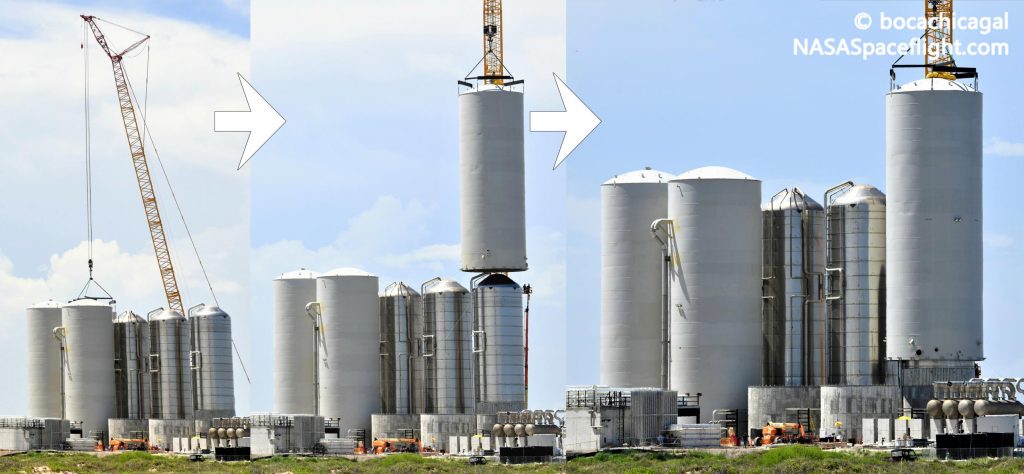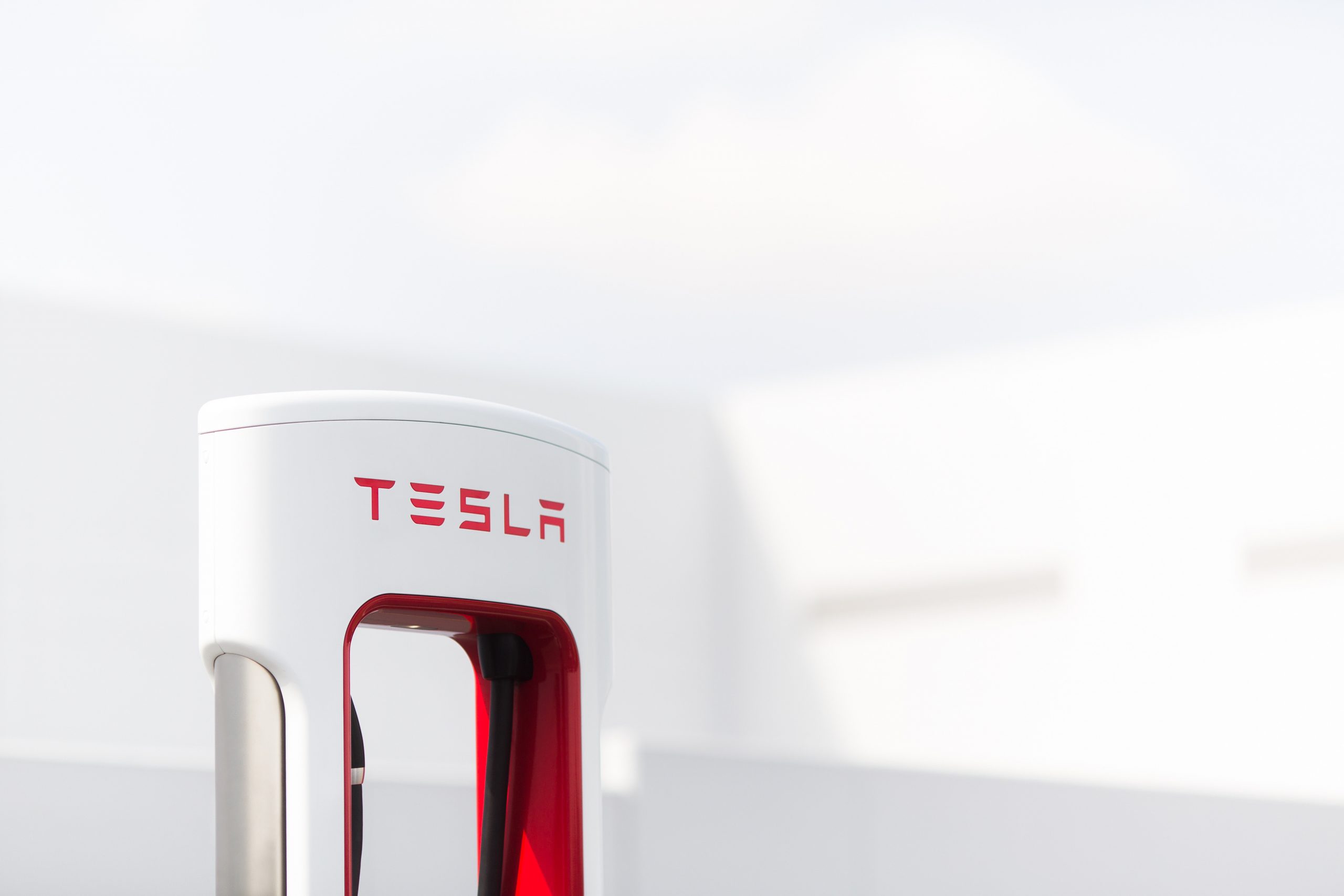

News
SpaceX to put custom Starship propellant storage tanks through first trial
In the latest twist in the saga of SpaceX’s custom-built Starship launch pad propellant storage tanks, the company appears to have retroactively decided to build small prototype meant solely for testing.
Known as a ‘test tank,’ the relatively small steel structure was fairly rapidly assembled from parts of an older Ground Support Equipment (GSE) tank scrapped in July over the last week or so. SpaceX completed the first Starship-derived propellant storage tank in April 2021 and rapidly rolled that tank (GSE1) and a second (GSE2) from the build site to the orbital launch pad just a few weeks apart. Less than a month after that, SpaceX also completed GSE tank #3, though things seemingly devolved into chaos immediately thereafter.
Only three months later would GSE3 finally be transported to – and installed on a concrete mount at – Starship’s first orbital launch site, and only after a number of structural modifications and in the footsteps of GSE tanks #5 and #6. Little is known about why SpaceX’s custom GSE tank production faltered so soon after it began, why none of the five Starship-sized tanks installed at the orbital pad have been fully plumbed or subjected to any kind of testing, or why structural modifications were seemingly required after the fact. However, it’s safe to say that SpaceX’s brand new GSE ‘test tank’ is now at the center of the mystery.

Thankfully, at minimum, the rapid appearance of SpaceX’s first GSE test tank returns some level of familiarity to the brief but chaotic history of Starship’s orbital launch pad propellant tanks. Test tanks are nothing new and have been an integral part of Starship development since Test Tank 1 first headed to SpaceX’s suborbital launch (and test) facilities in January 2020. In the 20 months since, SpaceX has built and tested seven small test tanks, several of which didn’t survive.
Whether intentionally destroyed or not, each test tank explicitly helped SpaceX qualify new manufacturing techniques, different materials, and different skin thickness and generally gather data more quickly and cheaply than full-scale prototypes would allow. Most recently, for example, SpaceX seemingly successfully tested a Super Heavy booster test tank, subjecting the prototype to cryogenic liquid nitrogen and using hydraulic rams to simulate the thrust of nine Raptor engines on an unproven disk-like thrust structure.
Now, almost as if SpaceX snapped out of a trance and remembered the utility of test tanks, the company has assembled a subscale GSE prototype presumably meant to verify that its custom-built propellant storage tanks can handle a set of conditions significantly different from the Starships they’re derived from. In this case, that GSE tank was quite literally built from scrapped sections of GSE tank #4. In fact, the top half (forward dome section) was quite literally cut off of GSE4 after the tank was scrapped last month for unknown reasons.
Over the last several months, while GSE tank production and installation took an unexpected hiatus, SpaceX workers slowly but surely welded steel rings (stiffeners) to the exterior of GSE1, GSE2, and GSE3. When GSE5 and GSE6 eventually headed to the pad, they left with those stiffeners already installed, implying that whatever tripped SpaceX up was likely structural. The GSE4 test tank also includes external stiffeners along each circumferential weld (where rings were stacked or domes joined).


At the same time as SpaceX was (or wasn’t, for several months) building its own GSE tanks, contractors normally tasked with assembling water towers and storage tanks in situ built eight massive 12m (~40 ft) wide tanks of their own. Deemed “cryo shells,” much like their name suggests, those tanks are meant to fully enclose SpaceX’s GSE tanks. SpaceX will use those shells to insulate their thin, single-walled steel propellant tanks, thus keeping their cryogenic contents cryogenic for as long as possible. How they’ll be insulated is unclear, though.
Based on the seemingly retroactive decision to strengthen the exterior of those GSE tanks, the general consensus as of late is that SpaceX wants to pull at least a partial vacuum in the gap between shell and tank. It’s also possible that SpaceX will do the opposite and pressurize that gap (as much as possible) with an insulative gas like nitrogen. Extra confusion comes from the fact that Starship tanks are technically designed to support a literal spacecraft (operating in a near-total vacuum) without the need for external stiffeners.
Additionally, it’s fairly clear that SpaceX hasn’t built a custom subscale cryoshell or concrete installation pad for its GSE4 test tank, meaning that it will really only be useful for testing some of the loads operational GSE tanks will experience inside their sleeves. Additionally, given that SpaceX has already completed six of the orbital pad’s seven GSE tanks and all seven of their cryosleeves, the discovery of any significant issues during GSE4 testing could easily trigger months of rework and delays. With any luck, though, GSE4 will sail through an imminent test campaign, clearing the way for SpaceX to finish plumbing, sleeving, and activating Starship’s first orbital launch site tank farm.

News
Tesla FSD’s newest model is coming, and it sounds like ‘the last big piece of the puzzle’
“There’s a model that’s an order of magnitude larger that will be deployed in January or February 2026.”

Tesla Full Self-Driving’s newest model is coming very soon, and from what it sounds like, it could be “the last big piece of the puzzle,” as CEO Elon Musk said in late November.
During the xAI Hackathon on Tuesday, Musk was available for a Q&A session, where he revealed some details about Robotaxi and Tesla’s plans for removing Robotaxi Safety Monitors, and some information on a future FSD model.
While he said Full Self-Driving’s unsupervised capability is “pretty much solved,” and confirmed it will remove Safety Monitors in the next three weeks, questions about the company’s ability to give this FSD version to current owners came to mind.
Musk said a new FSD model is coming in about a month or two that will be an order-of-magnitude larger and will include more reasoning and reinforcement learning.
He said:
“There’s a model that’s an order of magnitude larger that will be deployed in January or February 2026. We’re gonna add a lot of reasoning and RL (reinforcement learning). To get to serious scale, Tesla will probably need to build a giant chip fab. To have a few hundred gigawatts of AI chips per year, I don’t see that capability coming online fast enough, so we will probably have to build a fab.”
NEWS: Elon Musk says FSD Unsupervised is “pretty much solved at this point” and that @Tesla will be launching Robotaxis with no safety monitors in about 3 weeks in Austin, Texas. He also teased a new FSD model is coming in about 1-2 months.
“We’re just going through validation… https://t.co/Msne72cgMB pic.twitter.com/i3wfKX3Z0r
— Sawyer Merritt (@SawyerMerritt) December 10, 2025
It rings back to late November when Musk said that v14.3 “is where the last big piece of the puzzle finally lands.”
With the advancements made through Full Self-Driving v14 and v14.2, there seems to be a greater confidence in solving self-driving completely. Musk has also personally said that driver monitoring has been more relaxed, and looking at your phone won’t prompt as many alerts in the latest v14.2.1.
This is another indication that Tesla is getting closer to allowing people to take their eyes off the road completely.
Along with the Robotaxi program’s success, there is evidence that Tesla could be close to solving FSD. However, it is not perfect. We’ve had our own complaints with FSD, and although we feel it is the best ADAS on the market, it is not, in its current form, able to perform everything needed on roads.
But it is close.
That’s why there is some legitimate belief that Tesla could be releasing a version capable of no supervision in the coming months.
All we can say is, we’ll see.
Investor's Corner
SpaceX IPO is coming, CEO Elon Musk confirms
However, it appears Musk is ready for SpaceX to go public, as Ars Technica Senior Space Editor Eric Berger wrote an op-ed that indicated he thought SpaceX would go public soon. Musk replied, basically confirming it.

Elon Musk confirmed through a post on X that a SpaceX initial public offering (IPO) is on the way after hinting at it several times earlier this year.
It also comes one day after Bloomberg reported that SpaceX was aiming for a valuation of $1.5 trillion, adding that it wanted to raise $30 billion.
Musk has been transparent for most of the year that he wanted to try to figure out a way to get Tesla shareholders to invest in SpaceX, giving them access to the stock.
He has also recognized the issues of having a public stock, like litigation exposure, quarterly reporting pressures, and other inconveniences.
However, it appears Musk is ready for SpaceX to go public, as Ars Technica Senior Space Editor Eric Berger wrote an op-ed that indicated he thought SpaceX would go public soon.
Musk replied, basically confirming it:
As usual, Eric is accurate
— Elon Musk (@elonmusk) December 10, 2025
Berger believes the IPO would help support the need for $30 billion or more in capital needed to fund AI integration projects, such as space-based data centers and lunar satellite factories. Musk confirmed recently that SpaceX “will be doing” data centers in orbit.
AI appears to be a “key part” of SpaceX getting to Musk, Berger also wrote. When writing about whether or not Optimus is a viable project and product for the company, he says that none of that matters. Musk thinks it is, and that’s all that matters.
It seems like Musk has certainly mulled something this big for a very long time, and the idea of taking SpaceX public is not just likely; it is necessary for the company to get to Mars.
The details of when SpaceX will finally hit that public status are not known. Many of the reports that came out over the past few days indicate it would happen in 2026, so sooner rather than later.
But there are a lot of things on Musk’s plate early next year, especially with Cybercab production, the potential launch of Unsupervised Full Self-Driving, and the Roadster unveiling, all planned for Q1.
News
Tesla adds 15th automaker to Supercharger access in 2025

Tesla has added the 15th automaker to the growing list of companies whose EVs can utilize the Supercharger Network this year, as BMW is the latest company to gain access to the largest charging infrastructure in the world.
BMW became the 15th company in 2025 to gain Tesla Supercharger access, after the company confirmed to its EV owners that they could use any of the more than 25,000 Supercharging stalls in North America.
Welcome @BMW owners.
Download the Tesla app to charge → https://t.co/vnu0NHA7Ab
— Tesla Charging (@TeslaCharging) December 10, 2025
Newer BMW all-electric cars, like the i4, i5, i7, and iX, are able to utilize Tesla’s V3 and V4 Superchargers. These are the exact model years, via the BMW Blog:
- i4: 2022-2026 model years
- i5: 2024-2025 model years
- 2026 i5 (eDrive40 and xDrive40) after software update in Spring 2026
- i7: 2023-2026 model years
- iX: 2022-2025 model years
- 2026 iX (all versions) after software update in Spring 2026
With the expansion of the companies that gained access in 2025 to the Tesla Supercharger Network, a vast majority of non-Tesla EVs are able to use the charging stalls to gain range in their cars.
So far in 2025, Tesla has enabled Supercharger access to:
- Audi
- BMW
- Genesis
- Honda
- Hyundai
- Jaguar Land Rover
- Kia
- Lucid
- Mercedes-Benz
- Nissan
- Polestar
- Subaru
- Toyota
- Volkswagen
- Volvo
Drivers with BMW EVs who wish to charge at Tesla Superchargers must use an NACS-to-CCS1 adapter. In Q2 2026, BMW plans to release its official adapter, but there are third-party options available in the meantime.
They will also have to use the Tesla App to enable Supercharging access to determine rates and availability. It is a relatively seamless process.








